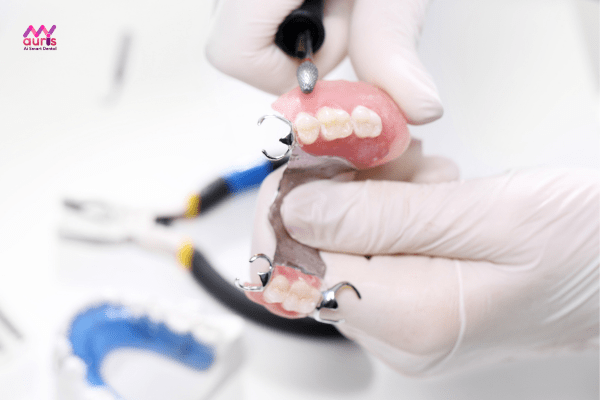Dentures are a method that helps many people restore lost teeth to improve aesthetics as well as chewing function. Each method has its own advantages and disadvantages, depending on each person’s condition, the doctor will advise on the appropriate treatment method. Sowhich type of denture is good, let’s follow the following article with My Auris dentistry.
Current methods of making dentures
Currently, according to dental statistics, the causes of tooth loss are many and can occur in any subject, because it can come from accidents, tooth decay, pulpitis, etc. If in the past, people who lost teeth were often subjective, but today, the advancement of science and technology helps us realize the dangers of long-term tooth loss. If you don’t get dentures early, you will not only lose aesthetics and reduce your chewing power, but you will also lose your jawbone.
If in the past the only option was to have removable teeth, now there are more improved methods, bringing many advantages: porcelain bridges and dental implants. Understanding the advantages and disadvantages of each method also helps people choose and consider the best and most suitable type of denture.
Removable dentures
Removable dentures are a method of dental implants that have long been known to many people. tooth loss. The structure of a denture includes a jaw base or a jaw frame made of plastic or metal that supports the plastic or porcelain dentures above. The jaw is fixed with metal clasps or the jaw frame is installed directly on the teeth adjacent to the missing tooth.
Removable dentures have 2 types: full dentures and partial dentures
- Full denture: the jaw base is made from Acrylic plastic, has a light pink color similar to the color of real gums. This type of jaw is often prescribed for people who have lost all their teeth, especially the elderly.
- Partial denture: composed of a metal frame usually made from titanium, on both sides are joints to help fix the jaw, on the tooth base can be plastic teeth or porcelain teeth.
Advantages
- Lowest cost among denture methods
- Simple technique, quick to perform, only takes about 2-3 days to wait for the denture to be crafted according to each person’s personal specifications.
- Safe, benign material that does not cause allergies or irritation in the oral cavity environment
- Easy to disassemble at home for cleaningoral
- Covers missing teeth gaps, ensures chewing food

Disadvantages
- Dentures are easy to loosen, fall, or slip, causing problems when chewing after use.
- The metal hook of the partial denture is easily exposed when eating, drinking, and communicating.
- Aesthetics are not high, dentures are easy to recognize
- Limited chewing ability, weak placenta strength, only restores about 30-40% of the chewing power of real teeth
- After a period of use, saliva seeps into the denture and will create an unpleasant odor, leading to bad breath.
- Using removable dentures for a long time will exert continuous force on the gums in the missing tooth space, leading to gum irritation.
- Must be removed when cleaning, causing many inconveniences
- Cannot prevent jaw bone loss due to tooth loss. Because dentures only restore tooth crowns and cannot replace tooth roots below the jawbone. Therefore, after time, bone loss still occurs, causing the face to become unbalanced, aging, and the skin to wrinkle and sag before age.
- The average lifespan is short, only having to replace a new jaw every 3-5 years.
Ceramic dental bridge
Ceramic dental bridge is a method of making dentures to restore lost tooth crowns for aesthetics. This method is effective for cases where one or several adjacent teeth are lost. To do this, the doctor must grind away 2 real teeth adjacent to the missing tooth to have the appropriate ratio to serve as pillars to support the porcelain bridge for the lost tooth.
The porcelain bridge series consists of porcelain teeth adjacent to each other, the teeth have the same color, shape, and size as real teeth. The number of teeth on a porcelain bridge depends on the number of missing teeth in the jaw. For example, if one tooth is lost, the porcelain bridge row will have 3 teeth, of which the 2 teeth at both ends of the bridge act as supporting pillars, and the middle tooth replaces the lost tooth.
When making porcelain bridges, it requires a doctor’s skills, expertise and experience to grind teeth at the right rate, avoiding wearing away tooth enamel and affecting the tooth pulp.
- Ensures high aesthetics
- Ensures higher chewing ability than removable dentures, restoring about 60-70% of the chewing force of real teeth
- Safe, benign material, does not cause allergies or irritation. There are two types of porcelain: metal porcelain and all-ceramic teeth. Among them, all-ceramic teeth are highly appreciated by experts for their quality, color, hardness, and durability compared to metal-ceramic teeth.
- Relatively high service life, on average 7-10 years.

Disadvantages
- Difficult if restoring missing incisors, canines and molars.
- Not effective in cases of multiple tooth loss.
- Impacts and invades real teeth. If you are not careful while grinding your teeth, you can damage the tooth pulp. In the long term, the tooth supporting the abutment will weaken and the tooth may be lost permanently.
- Cannot prevent jaw bone loss because only the crown of the tooth is restored without affecting the tooth root.
- If you do not clean underneath the porcelain bridge thoroughly, it will create conditions for food and plaque to accumulate, causing bacteria to invade and attack the real tooth pulp, causing disease.
- The cost is quite high but has to be done many times.
Dental implants
Dental implants are also known as dental implants – this is the most modern method of making dentures today because it not only restores the crown but also restores the root to create a complete tooth. adjusted like real teeth.
When performing an implant, the doctor will place a titanium implant post inside the jawbone. After that, the implant integrates with the jawbone into a solid block and then restores a porcelain crown on top.
Dental implants are composed of 3 parts: implant post, abutment joint and ceramic crown.
- Implant post: made from titanium with high mechanical properties, norust, abrasion and extremely safe for the body. The post replaces the real tooth root in the jawbone.
- Abutment joint: made of metal, designed in 2 parts, has the role of connecting the implant post and the porcelain crown.
- Ceramic crown: has the same color, design, shape, and size as real teeth. Porcelain can be metal or all-ceramic.
Advantages
- Prevents jaw bone loss due to increased loss
- Highly aesthetic, natural teeth like real teeth
- Applies to all cases of tooth loss
- Non-invasive, affecting neighboring teeth
- Minimize oral diseases
- Durable, ensuring almost absolute chewing, up to 98% of the chewing force of real teeth.
- High average lifespan, up to 20 years, even forever if well cared for.

Disadvantages
- High cost
- Long treatment time
What kind of dentures are good?
Perhaps through the advantages and disadvantages in the above section, everyone can see which type of denture is good, but to evaluate the suitability for you, you need to consider some of the following factors:
- Location and number of missing teeth
- Jaw bone quality should be used for dentures
- Customer Health
- Dental condition
- Based on economic conditions

Hopefully with the sharing aboutwhat type of denture is good, people understand better about From there, consider your own factors to choose the most suitable method. Please contact My Auris dentistry immediately for advice and support as soon as possible.
Mr. medium”>





